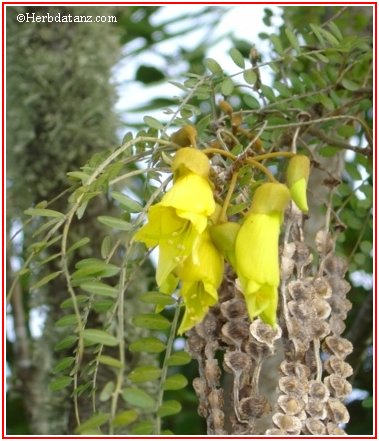

Sophora microphylla. Aitken
Common Name: Kowhai.
Leguminosae (pea family)
Medical properties: Analgesic, Dermatic, Emetic.
Part Used: Sun side inner bark. Leaves and Flowers.
Preparations: Infusion, Decoction. Extract, Tincture, Soft Extracts.
Notes : This small graceful tree is to be found in both the North and South Islands of New Zealand. It flowers in the early Spring (Sept) in New Zealand. Its related specie, Sophora tetraptera is restricted to the East coast of the North Island. Brooker, Cambie and Cooper have stated 'Probably both species will have similar properties.' In addition to its medical properties it also provides food for the Native Wood Pigeon and Bell Bird. There are 8 species of Microphylla in New Zealand. In the past the wild harvesting of medicinal plants has led to the extinction of many species. Far better to plant a tree and then harvest a couple of kilos of leaves and flowers. Always strip the bark from the sun side of the tree. The ultra violet rays from the sun are bactericidal and protect the wound. Stripping bark from the trunk of the tree is bad practice. Instead lop off a small growing branch. The bark is young and vigorous and can easily be stripped with a craft knife. Treat the tree with respect.
Preparations of the inner bark are analgesic and dermatic and are taken internally and used externally for pain and skin irritations. The leaves and flowers taken as an infusion are emetic. Therefore would be of use to empty the gastric contents in the event of poisoning.
Dosage as an infusion is 25 grams of leaves and flowers to 500 ml of freshly boiled water and then steep for 15 minutes. When preparing the inner bark for extraction it should be in the dried state and reduced to a coarse powder. Chop the bark into small pieces and put them into a domestic coffee grinder. I consider that the 15 minutes simmering time required of a decoction will more than likely decompose bio active substances. I recommend a 1 hour infusion time. Tincture strengths 1:5 and 1:10 in 70% alcohol.
Ivor Hughes
![]()